Kerala Plus One Zoology Notes Chapter 5 Digestion and Absorption
What is digestion?
This process of conversion of complex food substances to simple absorbable forms is called digestion.
DIGESTIVE SYSTEM:
It includes
- Alimentary canal
- Associated glands.
Alimentary canal:

The human digestive system
1. The alimentary canal begins with the mouth, and it leadsto the buccal cavity or oral cavity.
2. The oral cavity has a number of teeth and a musculartongue. Each tooth is embedded in a socket of jaw bone. This type of attachment is called thecodont.
3. Human being forms two sets of teeth during their life, a set of temporary milk or deciduous teeth replaced by a set of permanent or adult teeth. This type of dentition is called diphyodont.
Dental formula of adult human
An adult human has 32 permanent teeth which are of four different types (Heterodont dentition).
- incisors (I)
- canine (C)
- premolars (PM)
- molars (M).
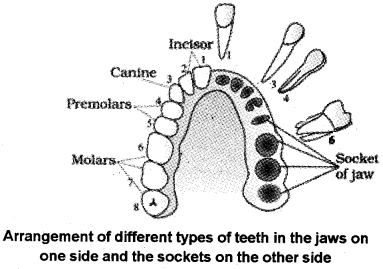
Arrangement of teeth in each half of the upper and lower jaw in the order I, C, PM, M is represented by a dental formula which in human is \(\frac{2123}{2123}\)
- The hardest part of teeth is made up of enamel, helps in the mastication oWood.
- The tongue is attached to the floor of the oral cavity by the frenulum.
- The upper surface of the tongue has small projections called papillae, some of which bear taste buds.
- The oral cavity leads pharynx which serves as a common passage for food and air.
- The oesophagus and the trachea (wind pipe) open into the pharynx.
- A cartilaginous flap called epiglottis prevents the entry of food into the glottis – opening of the wind pipe – during swallowing.
- The oesophagus is a thin, long tube which passing through the neck, thorax and diaphragm and leads to a ‘J’ shaped bag like structure called stomach.
- A muscular sphincter (gastro-oesophageal) regulates the opening of oesophagus into the stomach.
The stomach, located in the upper left portion of The abdominal cavity, has three major parts:
- A cardiac portion into which the oesophagus opens
- A fundic region and
- A pyloric portion which opens into the first part of small intestine
Small intestine is distinguishable into three regions:
- A ‘U’ shaped duodenum
- A long coiled middle portion jejunum and
- A highly coiled ileum
The opening of the stomach into the duodenum is guarded by the pyloric A sphincter. Ileum opens into the large intestine.

Large intestine:
It consists of
- caecum
- colon
- rectum.
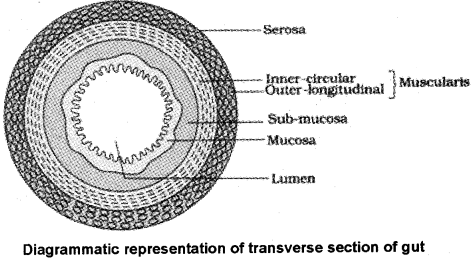
Caecum:
It is a small blind sac consists of some symbiotic micro-organisms. A narrow finger-like tubular projection, the vermiform appendix which is a vestigial organ, arises from the caecum. The caecum opens into the colon.
colon:
It is divided into three parts-an ascending, a transverse and a descending part. The descending part opens into the Rectum.
Rectum: It opens out through the anus.
Wall layers of alimentary canal:
It consists of four layers namely
- Serosa
- muscularis
- sub-mucosa &
- mucosa.
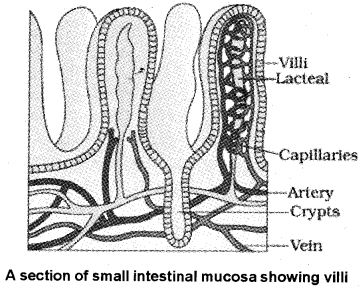
- Serosa is the outermost layer and is made up of a thin mesothelium with some connective tissues.
- Muscularis is formed by smooth muscles
- The submucosal layer is formed of loose connective tissues containing nerves, blood and lymph vessels.
- The innermost layer lining of the alimentary canal is the mucosa.
- In duodenum, glands are also present in sub-mucosa.
- Mucosa forms irregular folds (rugae) in the stomach and small finger-like foldings called villi in the small intestine
- The cells lining the villi produce numerous projections called microvilli giving a brush border appearance.
- These modifications increase the surface area.
- Villi are supplied with a network of capillaries and a large lymph vessel called the lacteal.
- Mucosal epithelium has goblet cells which secrete mucus that help in lubrication.
- Mucosa also forms glands in the stomach (gastric glands) and crypts in between the bases of villi in the intestine (crypts of Lieberkuhn).
Digestive Glands:
It includes
- salivary glands
- liver
- pancreas.
1. Salivary glands:
Saliva is mainly produced by three pairs of salivary glands
- parotids (cheek)
- sub-maxillary/sub-mandibular (lower jaw)
- sublinguals (below the tongue).
The duct systems of liver, gall bladder and pancreas These glands situated just outside the buccal cavity secrete salivary juice into the buccal cavity.
2. Liver:
- It is the largest gland of the body weighing about 1.2 to 1.5 kg in an adult human.
- It is situated in the abdominal cavity, just below the diaphragm and has two lobes.
- The hepatic lobules are the structural and functional units of liver containing hepatic cells arranged in the form of cords.
- Each lobule is covered by a thin connective tissue sheath called the Glisson’s capsule.
- The bile secreted by the hepatic cells passes through the hepatic ducts and is stored in the gall bladder.
- The duct of gall bladder (cystic duct) along with the hepatic duct from the liver forms the common bile. duct
- The bile duct and the pancreatic duct open together into the duodenum which is guarded by the sphincter of Oddi.

3. Pancreas:
It is a heterocrine (both exocrine and endocrine) elongated organ situated between the limbs of the ‘U’ shaped duodenum.
Secretions of exocrine and endocrine:
- The exocrine portion secretes an alkaline pancreatic juice containing enzymes
- The endocrine portion secretes hormones, insulin and glucagons.
DIGESTION OF FOOD:
- The process of digestion is accomplished by mechanical and chemical processes.
- The teeth and the tongue with the help of saliva masticate and mix up the food thoroughly. Mucus in saliva helps in lubricating and adhering the masticated food particles into a bolus.
Contents of saliva:
It contains electrolytes (Na+, K++, Cl–, HCO–“) and enzymes, salivary amylase and lysozyme.
The chemical process of digestion is initiated in the oral cavity by the carbohydrate splitting enzyme, the salivary amylase( pH 6.8).
Digestion of starch:
About 30 percent of starch is hydrolysed here by salivary amylase (optimum pH 6.8) into a disaccharide -maltose.
![]()
Enzyme for preventing infections:
Lysozyme present in saliva acts as an antibacterial agent that prevents infections.
- The bolus is then passed into the pharynx and then into the oesophagus by swallowing or deglutition.
- The bolus further passes down through the oesophagus by successive waves of muscular contractions called peristalsis.
- The gastro-oesophageal sphincter controls the passage of food into the stomach.
Mucosa of stomach and gastric glands:
Gastric glands have three major types of cells namely
| (i) mucus neck cells which secrete mucus (ii) peptic or chief cells which secrete the proenzyme pepsinogen and (iii) parietal or oxyntic cells which secrete HCI and intrinsic factor (factor essential for the absorption of vitamin B12). |
Digestion in the stomach:
1. The food mixes thoroughly with the acidic gastric juice of the stomach by the churning movements of its muscular wall and is called the chyme.
2. The proenzyme pepsinogen, in the presence of hydrochloric acid gets converted into the active enzyme pepsin, the proteolytic enzyme of the stomach.
3. Pepsin converts proteins into proteases and peptones (peptides).
4. The mucus and bicarbonates play an important role in lubrication and protection of the mucosal epithelium from concentrated hydrochloric acid- pH (pH 1.8).
Special type of proteolytic enzyme in infants:
Rennin is a proteolytic enzyme found in gastric juice of infants which helps in the digestion of milk proteins. The bile, pancreatic juice and intestinal juice are the secretions released into the, small intestine.
Pancreatic juice:
It contains inactive enzymes
| 1. Trypsinogen, 2. chymotrypsinogen, 3. procarboxypeptidases, 4. amylases, lipases and 5. nucleases. |
Trypsinogen is activated by an enzyme, enterokinase, secreted by the intestinal mucosa into aqtive trypsin.
Contents of Bile and functions:
The bile released into the duodenum contains bile pigments (bilirubin and biliverdin), bile salts, cholesterol and phospholipids but no enzymes Bile helps in emulsification of fats, i.e., breaking down of the fats into very small micelles.
Bile also activates lipases. The intestinal mucosal epithelium has goblet cells which secrete mucus. The secretions of the brush border cells of the mucosa alongwith the mucus constitute the intestinal juice or succusentences.
Intestinal juice/succus entericus:
It contains enzymes like
- disaccharidases (eg: maltase)
- dipeptidases
- lipases,
- nucleosidases etc.
How does the intestine protect itself from digestion?
1. The mucus alongwith the bicarbonates from the pancreas protects the intestinal mucosa from acid as well as provide an alkaline medium (pH 7.8) for enzymatic activities.
2. Sub-mucosal glands (Brunner’s glands) also help in this.

The breakdown of biomacromolecules occurs in the duodenum region of the small intestine. The simple substances thus formed are absorbed in the jejunum and ileum regions of the small intestine. The undigested and unabsorbed substances are passed on to the large intestine.
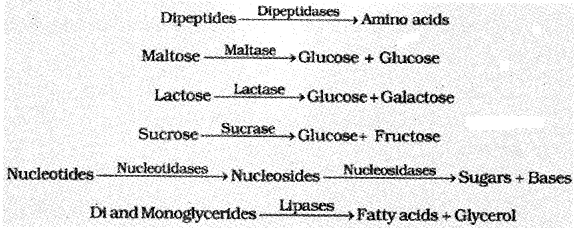
Functions of large intestine:
1. Absorption of some water, minerals and certain drugs
2. Secretion of mucus which helps in adhering the waste (undigested) particles together and lubricating it for an easy passage.
The undigested, unabsorbed substances called faeces enters into the caecum of the large intestine through ileo-caecal valve, which prevents the back flow of the faecal matter. It is temporarily stored in the rectum till defaecation.
- The sight, smell and the presence of food in the oral cavity can stimulate the secretion of saliva.
- Gastric and intestinal secretions are also stimulated by neural signals.
- The muscular activities of different parts of the alimentary canal controlled by neural mechanisms, both local and through CNS.
ABSORPTION OF DIGESTED PRODUCTS:
- The end products of digestion pass through the intestinal mucosa into the blood or lymph.
- It is carried out by passive, active or facilitated transport mechanisms.
- Small amounts of monosaccharides like glucose, amino acids and some the electrolytes like chloride ions are generally absorbed by simple diffusion.
- Fructose and some amino acids are absorbed with the help of the carrier ions like Na+. This mechanism is called the facilitated transport.
- Transport of water depends upon the osmotic gradient.
- Various nutrients like amino acids, monosaccharides like glucose, electrolytes like Na+ are absorbed into the blood by active transport and hence requires energy.
How does fat absorption occur?
Fatty acids and glycerol being insoluble, cannot be absorbed into the blood. They are first incorporated into small droplets called micelles which move into the intestinal mucosa. Then, the fat globules are coated with small protein called as chylomicrons which are transported into the lymph vessels (lacteals) in the villi.
These lymph vessels ultimately release the absorbed substances into the blood stream. The maximum absorption occurs in the small intestine. The absorbed substances finally reach the tissues which utilise them for their activities. This process is called assimilation.
The digestive wastes, solidified into faeces in the rectum initiate a neural reflex causing an urge for its removal. The egestion of faeces to the outside through the anal opening (defaecation) is a voluntary process and is carried out by a mass peristaltic movement.

DISORDERS OF DIGESTIVE SYSTEM:
Jaundice:
The liver is affected, skin and eyes turn yellow due to the deposit of bile pigments.
Vomiting:
It is the ejection of stomach contents through the mouth. This reflex action is controlled by the vomiting centre in the medulla. „
Diarrhoea:
The abnormal frequency of bowel movement and increased liquidity of the faecal discharge is known as diarrhea. It reduces the absorption of food.
Constipation:
In constipation, the faeces are retained within the rectum as bowel movements occur irregularly. ‘
Indigestion:
In this condition, the food is not properly digested leading to a feeling of fullness. The causes are inadequate enzyme secretion, anxiety, food poisoning, overeating, and spicy food.
NCERT SUPPLEMENTARY SYLLABUS
Calorific value of carbohydrate, protein and fat:
Carbohydrates, proteins and fats are chief sources of energy in humans. These are oxidized and released energy stored in ATP, it is used for many activities of the cell.
calorific value kcal = 4.184kJ):
It is defined as the amount of heat produced in calories (cal) or in joules (J) from complete combustion of 1 gram food in a bomb calorimeter (a closed metal chamber filled with 02). One kilocalorie is the amount of heat energy needed to raise the temperature of one kilogram of water through 100C(1.80F).
The calorific values of carbohydrates, proteins and fats are 4.1 kcal /g, 5.65 kcal /g and 9.45 kcal/g, respectively. The actual amounts of energy liberated in the body by these nutrients referred to as the physiologic value of the food, and are 4.0 kcal /g, 4.0 kcal Ig and 9.0 kcal /g respectively.
DEFICIENCY DISEASES:
The low amount of nutrients (Vitamin A, iron and iodine) in the diet cause deficiency disorders The important among them is protein energy malnutrition (PEM). lt is major health and nutritional problems in India.
Young children (0-6 years) require more protein for each kilogram of body weight than adults. So they are more vulnerable to malnutrition. Malnutrition leads to permanent impairment of physical and mental growth and childhood mortality and morbidity. The details of the disorders are given below.
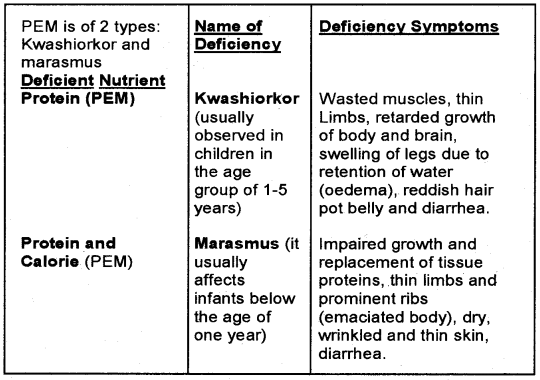
The child suffering from PEM can recover if adequate quantities of protein and carbohydrate-rich food are given.
